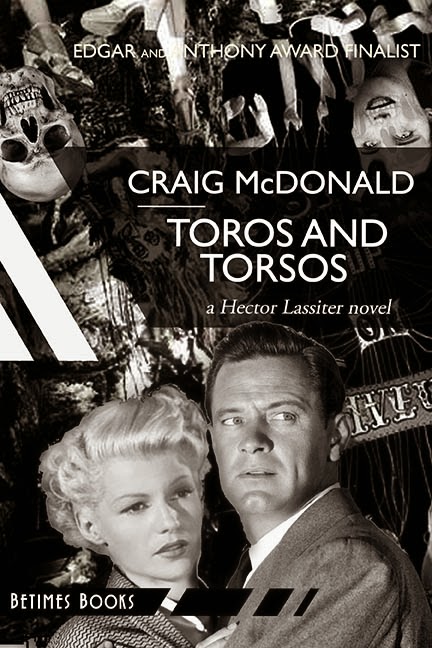(Note: Covers can make or break a book. The fact is, we do judge books by their covers. This is the second in a series of posts examining the strategies, concepts and creative process behind the repackaging of the Hector Lassiter series into bestselling, uniform editions for Betimes Books).
It spans four decades and moves from 1935 Key West to 1937, Civil War-era Spain; from 1947 Hollywood to 1959 Cuba, before at last wrapping up in New Mexico, circa 1961.
The cast includes a mix of fictional and historical characters including Ernest Hemingway, John Dos Passos, Orson Welles, Rita Hayworth, Vincent Price and John Huston.
The novel also concerns itself with recent theories that the murder of Elizabeth Short, the infamous "Black Dahlia," was the work of someone or some people very much preoccupied by the Surrealist art movement.
 I took that concept and layered in more crimes and excesses that have been laid at the feet of the surrealists by recent scholarship.
I took that concept and layered in more crimes and excesses that have been laid at the feet of the surrealists by recent scholarship.For its original American publication by Bleak House Books, I was able to exert my own vision for the book's packaging.
I had also had some influence on the final look of "Head Games" for Bleak House. For its sequel, we kept a kind of three-tiered design established for HG.
 |
| The Rivera Studio depicted in the painting. |
The main image that would front the first American edition of T&T was one found by my agent, Svetlana Pironko, that seemed to embody much of the themes and the sinister/sexy surrealistic feel of the book. Also, for a book so very much about surrealist art, it seemed necessary to have a proper surrealist's illustration front the novel.
The artist is the great Diego Rivera, and the work is called "In the Studio of the Maestro." The Rivera (and Kahlo) works are in the care of the Bank of Mexico, and so, working through various intermediaries and translators, we were able to secure rights for the painting's use.
As the novel moved further out into the world, it got some different packaging. The Korean version incorporates an illustration of a work by Pablo Picasso referenced in the novel.
As the novel moved further out into the world, it got some different packaging. The Korean version incorporates an illustration of a work by Pablo Picasso referenced in the novel.
The French versions of "Toros & Torsos" (retitled "Rhapsody in Black" over there, a confusing development perhaps for readers given that is also the given title of Hector Lassiter's own first-published novel), tended to put women front and center, a consistent theme in the branding of my series in those environs.
When it came time to repackage the novel for Betimes Books' new uniform edition of the Lassiter series, the overall graphic design of the look was pretty well set. The question was one, really, of imagery and color choice.
The image of Beth Short is so associated with James Ellroy's breakthrough novel, "The Black Dahlia," we were resistant to use Miss Short's face too prominently or overtly. (And, frankly, there aren't that many images of Elizabeth Short extant to work with beyond the one adorning the Ellroy novel.)
We tried some very noir concepts like the below, but ulimately abandoned those—they failed, in the end, to put across the artistic subtext that informs the novel.
Next we tried some spins on the infamous crazy house set designed by Orson Welles for "The Lady from Shanghai," a crucial set-piece portion of "Toros & Torsos." (Welles' bizarre set and its severed limbs and torsos would later result in some actually pointing to Orson as a potential, viable suspect in Short's murder, a subplot of T&T.)
In the end, we choose to focus on the title character and Rita Hayworth, with the most iconic image of Elizabeth Short transformed into a kind of Russian nesting-doll evoking surrealist imagery and some works by Salvador Dali.
Once again, the design and execution of the below is the work of the remarkable J.T. Lindroos, who is giving the Hector Lassiter series its striking, signature look across its span.
At this writing, eight of the ten Lassiter volumes coming from Betimes Books have at last found their definitive covers.
All that remains are a cover for the climactic novel in the series, "Three Chords & The Truth," and a collection of short stories featuring Hector that we'll be calling, "Write from Wrong."
NEXT UP: IT'S ALL "PRETEND"
——————




















































